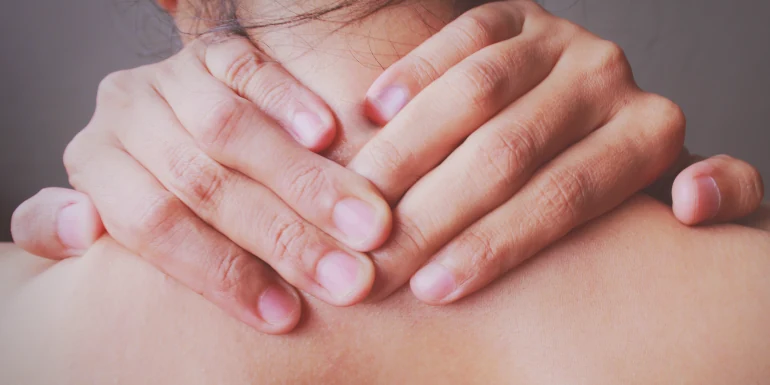
What can you do about back pain?
Back pain affects 80 percent of all Swiss people at least once in their lives and can be very disruptive day to day. Whether you feel pain in your upper, middle or lower back, these are possible causes of your back problems and what you can do about them.
Not all back pain is the same. Most people with acute back pain feel better in just a few days or weeks. This non-specific pain often has no obvious cause.
Possible causes of back pain
The causes of back pain include:
- heavy physical work
- unequal weight distribution in everyday life
- long periods of sitting
- lack of exercise
- accidents and falls
- stress-related tension
The causes of back pain are many and varied. Weak muscles generally increase the likelihood of being affected by back pain, which can be felt in one or more areas of the back for days or even weeks.
Fortunately, around 90 percent of back problems do not involve any recognisable illnesses such as a herniated disc or signs of wear and tear. Back pain is usually caused by muscle tension or irritation of ligaments or tendons. The first thing to do is to localise the pain: where does your back hurt?
Lower back pain
Do you have lower back pain? Back pain is particularly common in the lumbar spine area, where it is also known as lumbago. This is not surprising when you consider that almost the entire weight of the torso acts on the lumbar spine. It is exposed to a great deal of stress in everyday life, whether through sitting, standing, turning, bending, or picking up or carrying objects.
Lower back pain is often caused by staying in the same body position for a lengthy period (e.g. sitting for a long time) or repeated unequal distribution of weight. If the pain is particularly acute, it could also be a case of lumbago.
If the pain radiates into your legs (sciatica) or arms, it could possibly be a herniated disc.
Middle back pain
Sudden or cramp-like pain in the middle back can radiate laterally into the rib area and can be very uncomfortable. Since the thoracic vertebral column supports the ribcage, the vertebrae in this area are slightly less mobile. Pain in the middle of the back can often feel like a “blockage”.
Middle back pain, also known as thoracic spine syndrome, is often due to a lack of exercise. However, it can also be triggered after a fall or sudden movement. People who stay in the same position or sit for a long time without moving around can regularly be affected by middle back pain.
Upper back pain
If you feel pain in your upper back, it is referred to as cervicalgia. This pain at the level of the cervical spine or directly below is often caused by muscle tension in the shoulder and neck region. Stress, incorrect posture or staying in the same body position for a long time often lead to this tension. This very unpleasant upper back pain can also radiate to the neck and shoulders and is often perceived as pulling or burning.
We often tilt our heads downwards when using a smartphone or computer. This can exacerbate poor posture that causes pain. In this case, strengthening and stretching exercises as well as relaxation techniques can bring relief.
If back pain occurs more frequently in the morning after waking up, unfavourable sleeping conditions may also be the cause: it’s worth checking your pillow and mattress and replacing them if necessary.
You can treat many back problems yourself, as back pain often subsides after a little while. If your back pain is very severe, lasts for a long time or if there are other symptoms such as tingling, a sensation of paralysis or fever, your first point of contact is your GP. Depending on the severity, back pain after accidents should also be looked at by the paramedics (in an emergency) or by your GP.
They can give you personal advice after an examination and, if necessary, refer you to a physiotherapist, osteopath, chiropractor or pain therapy specialist.
In rarer cases, however, other illnesses, such as respiratory issues or problems with the back vertebrae, can also cause back pain. If back pain occurs very suddenly and intensely, is associated with nausea or feelings of weakness, or radiates into the chest, you should call the emergency services as soon as possible, as these could be signs of a heart attack.
Tackling back pain with complementary medicine
Complementary treatment such as massages, osteopathy and acupuncture can help with back problems. COMPLETA covers you for 75% of costs for outpatient treatment and 100% of costs up to a maximum of CHF 5,000 per year for inpatient treatment.
What helps combat back pain?
Regularly exercising your back muscles is the best way to avoid back pain. You can do this through strength training, swimming, yoga or Pilates. The following treatment methods can provide relief for acute back pain:
- Heat: place a heat patch from the pharmacy or a hot water bottle on the affected area. Heat can relieve back pain because it can ease tension and loosen tight muscles.
- Exercise: light exercise is often better than resting. A short walk in the fresh air can gently relieve tension and also helps with stress-related back pain.
- Psoas position: if you have lower back pain, it can help to lie on your back on a blanket on the floor and place your lower legs on a stool so that your hip and knee joints form an angle of approximately 90 degrees. This position relieves the lumbar spine and reduces pressure on the nerve roots.
If the pain persists or feels particularly intense, painkillers can also help in the short term. However, if the pain is severe, it’s a good idea to pay a visit to your GP.
Back pain can have many causes and presents in the lower, middle or upper back. Although there are specific back issues such as slipped discs, sciatica or lumbago, most types of back pain are due to muscle tension from staying in the same body position for too long or a general lack of exercise.
What’s key is identifying the causes of your aching back and taking appropriate measures to alleviate the symptoms.

The physiotherapist provided the editorial team with advice and input for this article. Stefan Wöll (graduate in physiotherapy) works for Helsana health consultation. He supports customers on questions to do with pain syndromes, sport and exercise.


Newsletter
Find out more about current health issues every month and get all the information you need about our attractive offers from all Helsana Group companies * delivered by e-mail to read whenever it suits you. Our newsletter is free of charge and you can sign up here:
We did not receive your information. Please try again later.
* The Helsana Group comprises Helsana Insurance Company Ltd, Helsana Supplementary Insurances Ltd and Helsana Accidents Ltd.